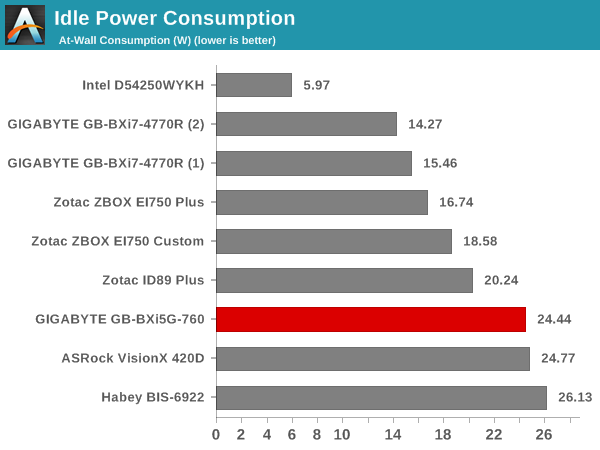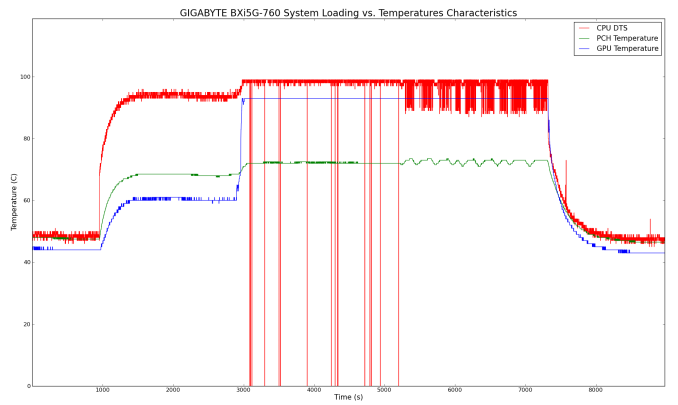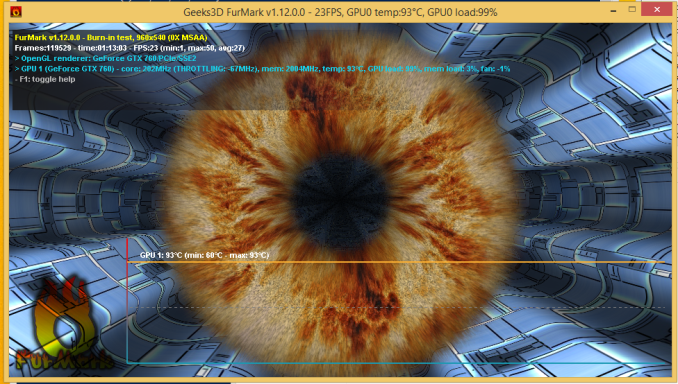GIGABYTE BRIX Gaming BXi5G-760 mini-PC Review
by Ganesh T S on September 15, 2014 2:30 PM ESTMiscellaneous Aspects & Final Words
The power consumption at the wall was measured with the display being driven through one of the mini-HDMI ports. In the graphs below, we compare the idle and load power of the BXi5G-760 with other low power PCs evaluated before. For load power consumption, we ran Furmark 1.12.0 and Prime95 v27.9 together. The BXi5G-760 is not the most power efficient PC around, but the target market (gamers) don't need to care too much. The numbers are not beyond the realm of reason for the combination of hardware components in the machine.


Even though the steady state power consumption in the simultaneous CPU and GPU loading case was around 105 W, we did see an initial spike into the 150 W range before stabilization.
Thermal Performance
Given the size of the chassis, throttling under heavy load was always a possibility. Our fears turned out to be true, as the two graphs below show. The various clocks in the system as well as the temperatures with the unit are presented below. For the first 15 minutes, we have the unit at idle. This was followed by 30 minutes of pure CPU loading, followed by another 30 minutes of both CPU and GPU being loaded simultaneously. We found throttling in effect at that point. After this, the CPU load was removed, allowing the GPU to be loaded alone for another 30 minutes.
In the graphs on either side, we find that the idle clocks are around 800 MHz for the CPU cores and around 135 MHz for the GPU, with the temperatures between 40 and 50 C inside the unit. With the plain CPU loading for 30 minutes, we find there is no throttling and the CPU temperatures stabilising around 94 C with the core clocks around 2.5 GHz. Once the GPU kicks into gear, we can see the red dips in the temperature graph below. Since we are graphing DTS here, a value of 0 means that the system needs to throttle to bring temperatures back in the operating range. The core clocks go down ro around 2.1 - 2.3 GHz. Note that the GPU clocks were only very briefly at the advertised 941 MHz. Eventually, under sustained loading, they end up oscillating between 202.5 MHz and 405 MHz. When the Prime 95 loading is taken off, the CPU has more headroom and ramps up to 3.4 GHz frequently to help keep the GPU loaded. An advantage with the active thermal solution is that the temperatures return to idling points very quickly after removal of the load.
The safe temperature limit for the GTX 760 has been set at 97 C, and we found that the solution in the BX i5G-760 levelled out around 93 C under these loading conditions. The GPU does fine-grained management of the clock frequency (which is interpreted by Furmark as throttling) to manage the thermals.
Concluding Remarks
GIGABYTE has managed to cram impressive gaming components into a small chassis. If there were a metric for gaming performance per cubic-foot, the BXi5G-760 would win it hands down. The NVIDIA GTX 760 / GTX 870M is also a top notch choice for gaming in this form factor. Its HTPC credentials are also excellent. The pre-integration of the WLAN component (Realtek-based 1x1 802.11ac) makes things very simple for the end user to complete the build. The triple-display output is a welcome feature for gamers.
On the pricing side, the BXi5G-760 comes in at $800 without the DRAM or a boot drive. That is steep for a machine with limited expansion possibilities. GIGABYTE has also tied up with 'Unified Remote' to provide control of the PC using mobile devices. It would have been nice on GIGABYTE's part to supply a few codes for the full version of the Unified Remote mobile app. That said, this is a nice alternative to the MCE remotes that other vendors are supplying with their mini-PCs.
In conclusion, if one is looking for a highly portable non-DIY gaming mini-PC, it is hard to go wrong with the GIGABYTE BXi5G-760.













35 Comments
View All Comments
Madpacket - Monday, September 15, 2014 - link
So an entire review on a gaming PC without mentioning how loud this thing gets while gaming? Really?Sm0kes - Monday, September 15, 2014 - link
Yeah, kind of odd that the most obvious question is performance vs. thermal limitations was completely missed.Check out Linus Tech Tip's video review of the unit. He goes into some detail on the noise (read: not good) and thermal throttling.
imaheadcase - Monday, September 15, 2014 - link
It should be pretty obvious to come to a conclusion on that without them telling you. Look at power numbers. They even say to look elsewhere if you are looking for better acoustics.wintermute000 - Monday, September 15, 2014 - link
Mystified why they don't make these gaming NUCs a little bit bigger. Then they could put bigger, slower fans in there + more airflow. Its not like making this thing an inch wider/longer would bother anyone looking for serious gaming grunt, still would be a relatively small unit.drainplugofideas - Monday, September 15, 2014 - link
I totally agree.flyingpants1 - Tuesday, September 16, 2014 - link
Actually, there's no point. All you need is a mini-ITX motherboard and a GTX760 Mini installed normally, and a Silverstone SFX 450W PSU. Fits PERFECTLY in a 6.7"x6.7"x4.8" box. And it costs wayyy less than this thing, even with an i5-4690 and M.2 SSD 256GB.There's no point whatsoever to this whole NUC thing. We already have an SFF standard, it's called mini-ITX. NUC is just more BS to pad Intel's bottom line. If you don't need dedicated graphics, buy mini-ITX with 120W power brick, whole system for under $190.
johnny_boy - Wednesday, September 17, 2014 - link
That is the whole point--you need dedicated graphics for gaming on ITX unless you're happy wih something like an AMD A8-7600 at 45W TDP, which is the best iGPU you can get with those thermals. But this brix box smokes a 7600. With dedicated graphics you're looking at a significantly larger case and higher wattage draw even if you go with Maxwell.figus77 - Friday, September 19, 2014 - link
If you really want play you should no look at any low powered small form factor PC... they simply can't let you play in a decent way... no one in 2014 wants to play at something less than 1920 and they can't do it in 90% of games and you sure had a full hd tv to use with them. With that 900$ you can do a normal gamig machine and an AM1 mini-itx system for TV... both better in their work.Popskalius - Monday, September 22, 2014 - link
Actually, I have no desire to game at anything higher than 720p... but I've also never gamed at 1080p or higher so take that could mean something.fteoath64 - Friday, October 3, 2014 - link
Even do water cooling with integrated radiator fins on one side protected by some course stainless steel mess. Sure make it a couple inches wider. It would by more stackable above a HT unit or something ....